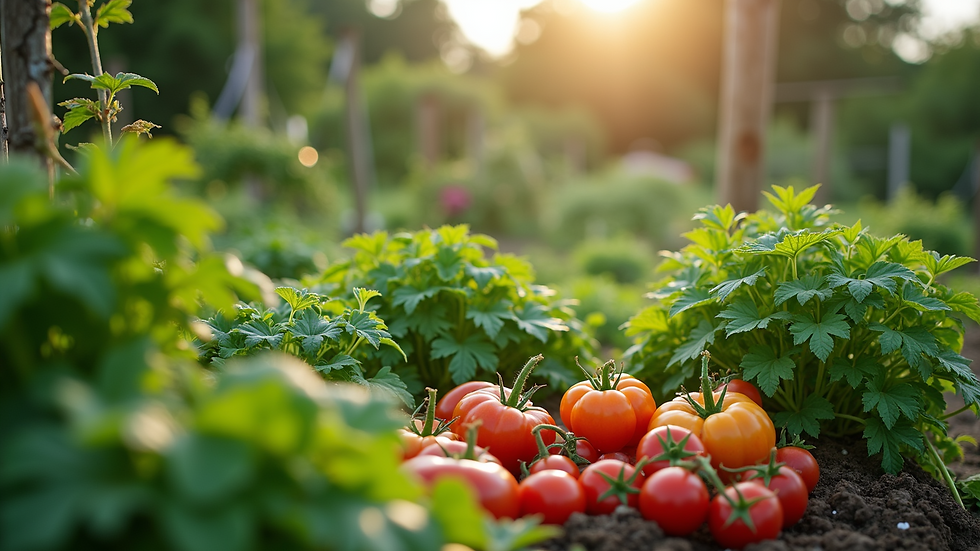Why Your Veggie Garden Needs BFFs: The Surprising Perks of Companion Planting
- Lulu's Farm

- May 26
- 3 min read
Updated: May 27
Have you ever noticed how some plants seem to thrive in the company of others? Just like friendships in our lives, certain plants can support each other in the garden and lead to remarkable benefits for your vegetable patch. Let’s explore the world of companion planting and see how you can create the ultimate veggie squad!
What is Companion Planting?
Companion planting involves growing different types of plants close together for their mutual benefit. This time-tested technique can increase crop yields, ward off pests, and even improve flavor. While it may sound straightforward, the advantages are diverse and worth investigating!
Improved Growth and Yields
Companion planting often results in enhanced plant growth and greater yields. Some plants efficiently share nutrients and water, boosting the overall health of your garden.
For instance, consider tomatoes paired with basil. Research shows that basil can increase tomato yields by up to 20%. Not only does basil enhance the taste of tomatoes, but it also helps keep pests like aphids and whiteflies at bay. By planting them together, you can enjoy a larger, more flavorful harvest.

Natural Pest Control
One of the standout advantages of companion planting is its potential for natural pest control. Certain plants can deter harmful insects or attract beneficial ones that keep pests in check.
For example, marigolds are a popular companion plant that emits a scent repelling nematodes and several other pests. When planted near tomatoes or peppers, marigolds can protect these vulnerable crops, fostering a healthier garden ecosystem. Studies show that gardens with marigold plants can reduce pest problems by as much as 30%.
Enhanced Flavor Profiles
Did you know that companionship among plants can also elevate their flavors? When plants are grown together that fulfill each other's needs, they produce fruits and vegetables that are tastier and richer.
For example, carrots and onions make a great pair. Carrots take in nutrients from the soil, while onions act as a protective shield. This partnership can lead to root vegetables with richer flavors that will delight your palate and impress your dinner guests.

Efficient Use of Space
In gardening, every square inch matters. Companion planting maximizes garden space by allowing plants with different root depths to coexist.
A well-known trio, corn, beans, and squash (the "Three Sisters"), perfectly showcases this principle. Corn provides a support structure for climbing beans, while broad-leaved squash helps suppress weeds and conserve moisture. This arrangement can yield significant harvests in a small area, with studies indicating that these combinations can produce up to 250% more food per square foot compared to single planting.
Soil Health Improvement
Improving soil health is another great benefit of companion planting. Certain plants, particularly legumes, have the unique ability to fix nitrogen in the soil. When interplanted with hungry crops like leafy greens or corn, these legumes add essential nutrients back into the earth.
Incorporating cover crops, such as clover or vetch, into your planting rotation can also boost organic matter in your soil. Research suggests that healthier soil leads to at least a 15% increase in crop yields during primary growing seasons. By nurturing your soil, you not only enhance your vegetable growth but also contribute to a thriving garden ecosystem.

Creating Plant Partnerships
Now that you're aware of the benefits, it's time to think about the plant partnerships for your garden. Here are a few effective combinations to consider:
Tomatoes with Companion Herbs (e.g., Basil and Oregano): Boost yields and deter harmful pests.
Spinach and Strawberries: Spinach offers shade to strawberries, which benefits from the nutrients as they grow.
Cucumbers and Nasturtiums: Nasturtiums repel aphids while adding vertical beauty and culinary interest.
Things to Consider
While companion planting presents numerous benefits, it is essential to remember that not all plants are compatible. Certain pairings can be detrimental. For example, planting potatoes and tomatoes together can increase the risk of blight.
It's wise to research which plants are beneficial and to monitor your garden closely to ensure that all plants get along well.
Wrapping Up
Companion planting goes beyond mere cohabitation; it fosters a balanced and productive garden ecosystem. By strategically pairing plants, you can cultivate healthier vegetables, manage pests naturally, and even enhance flavors.
Starting your companion planting adventure can be simple. Choose a few of your favorite vegetables and research which neighbors can join them. So why not get started? Plant some BFFs in your garden and enjoy a bountiful harvest full of delightful surprises. Happy gardening!




Comments